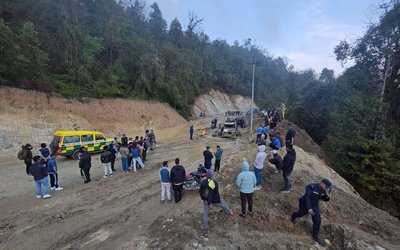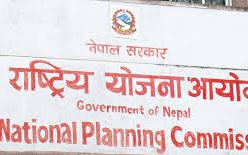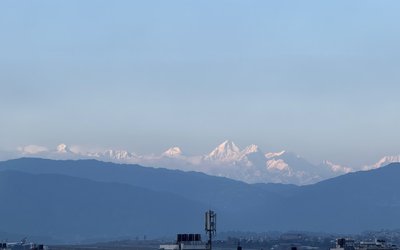
For decades, seventy-three years old, Amirkha Raidash, a resident of Barma Tole of Nepalgunj Sub-Municipality, Ward 18, used to live in fear because the monsoon rains, often torrential, regularly inundated her residence and locality. They were isolated from the rest of Nepalgunj city for weeks and children had to live inside home due to muddy road and water.
“Our area usually turned into a big pond. As the road to the highway was full of mud, we had no option other than to live in confinement from the rest of city for days," Raidash narrates her experience. "Being a poor person, we lived here facing all hardship and difficulties. If you cannot sell your land and purchase land elsewhere, the option was to live here. “With the completion of the project, you see the situation now is different. Even after the torrential rains of the last two days (15 and 16, September 2019), the water level had not risen. With a concrete pavement, children do not need to walk on mud."
Raidash is not alone in sharing the experience. Sumitra Godah, 32, had her better and bitter past." In the past, it took weeks to reduce the water level and inundation was a major problem for us. Now-a-days, the water is reduced within two to three hours of big rain. There were torrential rains for the last two days but you cannot see water here. Our children just come back from the school," said Gaudash.

Those were the days when people had to live in water inundated areas during the three months of monsoon. Situated in a low land with no proper sewerage and pavements on roads, residents of Barma Tole had to suffer the most.
For decades, the onset of rainy season used to be a season of pain for the residents of Nepalgunj Sub-Municipality and Barma tole was not an exception.
Suffering from monsoon cloudburst with torrential rains up to 150 mm in a matter of a day, most of the parts of Nepalgunj city submerged under water for weeks. Along with other district officers, Dhabal Sumsher Rana, mayor of Nepalgunj Municipality, used to visit the sites of different wards to console the people facing inundation. They even used small boats to supply relief materials and rescue people.
As the majority of the population of Barma Tole is poor, the project undertook Community Development Programs focusing on poverty pockets. While these women may not have not directly benefited from major infrastructure improvement projects, the project has improved the narrow lane by turning it into an all weather concrete road, with side drainage.

As a part of mainstreaming, Gender Equality and Social Inclusion (GESI), the project supported women groups of the areas to take part in the leadership role.
With the construction of pavement in Barma Tole, which is overwhelmingly a rural setting, access of the community to reach main center increased and vulnerability of water inundation reduced.
"The two flooding incidents of Kathmandu Valley, in Hanumante and Balkhu rivers, reminded me the past state of Nepalgunj. We lived in such an inundation for long. After the construction of proper sewerage and pavements, you see water no more than three hours which is at par or better than the target of project design. All the water flushes out within three hours from almost all Nepalgunj," said mayor Rana proudly. "All the citizens of Nepalgunj are grateful to Asian Development Bank for its support to make our city livable," said Rana.
With rain, all the urban roads turned muddy and children could not go to school due to water inundated roads. If someone got sick, it would the most difficult task to take him or her to the hospital.
The settlement started immediately after the Lukchnow Sepoy Mutiny, the unsuccessful Indian Rebellion of 1857; uprising against the rule of the British East India Company, by the rebels, who escaped from possible prosecution. Nepalgunj is one of the oldest cities of Nepal. As the first inhabitants of the city were exiled rebels, Nepal’s Rana rulers also chose the city to dump conspirators and their unfavorable relatives.

Flourishing after the East-India Company returned the districts, which Nepal had lost in 1814 War, Nepalgunj has remained the main entry point linking hills of Midwestern region to India and rest of the country.
Since its establishment, the city also linked Nepal's royalty to India's princely state. Even the current mayor of Nepalgunj married to a prince from Gwalior, formerly a princely state.
Facing many problems with lack of basic urban infrastructure, Nepalgunj and Siddharthanagar used to be prone to water inundation during the monsoon, unmanaged solid waste and lack of paved roads and proper drainage system.
The situation has changed now. Financed by Asian Development Bank through grant and loan, Integrated Urban Development Project (IUDP) has not only changed the landscape of two cities but also ended the woes of city people making water inundation as a history.
“Managing solid waste is one of the major challenges of urbanization. Nepalgunj could be an example to other cities on how this can be done even with limited resources,” said Rudi Van Dael, Head of Portfolio Management, Nepal Resident Mission, Asian Development Bank.“Improving urban infrastructure and service delivery in major urban areas in Nepal is very important given their importance to the country’s economy and development. ADB is working closely with the Government of Nepal for urban infrastructure development of 12 major cities in Nepal including 4 cities under the integrated urban development project.”

In accordance with the priorities of each municipality, integrated urban environmental improvements including drainage systems, solid waste management (SWM) facilities and urban roads are constructed in Nepalgunj. However, Siddarthanagar did not make SWM a reality due to failure to convince residence of SWM site surroundings.
"After the completion of the construction of proper drainage and road, the statistics explains that rain water flushes out within three hours of rain in Nepalgunj sub-metropolitan city and within less than one hour in Siddarthanagar Municipality Area as envisaged during project design," said Laxmi P. Subedi, senior Social Development Officer (Safeguard) of Asian Development Bank.
Implemented to provide the population in the Dharan, Janakpur, Nepalgunj and Siddarthanagar with better access to municipal infrastructure and services in a socially inclusive manner, Integrated Urban Development Project has drastically transformed the infrastructure of municipalities including urban environmental improvements, drainage systems, solid waste management facilities and urban roads including water supply system improvement in Dharan
"What we have achieved in the last five years is a miracle. Nobody ever assumed in the past that they would see flushing out the rainwater within a matter of three hours," said Mayor Dhabal Sumsher Rana.
Started two years before the election of local level in 2014, the project based on strong collaboration and partnership with local level, community and government agencies is one of the successful urban development projects.
Successfully completing urban services like urban flood protection, urban solid waste management with a well-equipped land-fill site, road and utility restoration, Nepalgunj Sub-Metropolitan city has shown its way to other municipalities as well.

At a time when many other municipalities are facing problems in accessing the site though land managed to acquire for land-fill sites including Siddharthanagar and Janakpur, Nepalgunj has started the operation of the modern landfill site. With the strong leadership of Mayor Dhabal Sumsher Rana and Deputy Mayor Uma Thapa Magar, people in the communities have joined hands to make the project a success.
"We have expanded the road acquiring the land with consent of community and people. In a similar manner, we also acquired the land for land-fill convincing people living around the landfill sites," said Mayor Rana. “What I have learnt from this project is that strong partnership, collaboration and coordination among development partners, community, government and local levels are keys to complete the project in success."
Having been part of the project by regularly monitoring the work, Laxmi P. Subedi, Senior Social Development Officer (safeguard) said that Nepalgunj has shown important role of leadership at local level, technical capacity and community to complete the project.
Head of ADB's Portfolio Management Rudi van Dael said that the project has also shown that community support is important for making a project successful. As Municipality has the land-fill site, solid waste management is very important service of municipality, waste management is always challenging."
As the project is on the verge of closing, Nepalgunj sub-Metropolitan city, which was one stage at the verge of collapse due to lack of urban facilities, has revived again to be a vibrant historical city.
Although the municipality has everything in its place now, what is lacking is the governance to regulate properly. With rampant dumping of plastic, wastes and construction materials here and there, these activities will likely reduce the life of infrastructure like road and drainage. Haphazard constructions of houses are also likely to create the problem.
The successful use of new urban infrastructure will be now depending upon the regulatory capacity of municipality. For this, it requires backing of political leadership.
“We will make every effort to enforce the urban law to end wrong practices. However, it cannot be done overnight. It may take a few more years. We have started to collect a nominal amount of money from city dwellers as part of their contribution for solid waste management,” said mayor Rana. “We have our own limitations but it is everyone’s duty to protect the infrastructure built with support from ADB, which helped us to revive the old city of Nepal.”
Siddharthanagar Municipality
At a time when there are delays in the completion of projects in scheduled time for road and drainage improvement component, Siddharthnagar Municipality has made exemplary work completing the project in time.
With the combined efforts, of Asian Development Bank, with constant monitoring, efficiency of government’s technical staff and backing of political leadership, Siddharthanagar Municipality was able to achieve the success.
“People of the municipality are grateful to ADB for its support to improve our urban infrastructure. Unlike in the past, the city has today all developed infrastructure like road, drainage and restoration of existing drinking water supply pipelines. We don’t need to worry about rain water and inundation anymore,” said Mayor Hari Prasad Adhikari. “As the project is at the final stage of completion, the municipality has also got a strong team of technically capable persons. They are our assets.”

Situated in the southern part of Nepal bordering India and a gateway to Lumbini, birthplace of Gautam Buddha, Siddharthanagar Municipality has drastically improved its urban infrastructure over the years. With the financial support from ADB, Gautam Buddha Lumbini International Airport is close to completion. The improved infrastructure will greatly contribute to the growth of the municipality.
“Providing support one after another, ADB has made us proud. Our municipality will be the second municipality, with the second international airport,” said mayor Adhikari.
Siddarthanagar Municipality was one of the highly inundation prone areas of Rupandehi district, with a quarter of its residential area and land of under water during four months of monsoon and floods.
One can see the difference now. After the implementation of Integrated Urban Development Project and Regional Urban Development Project (RUDP) under grant and loan support of Asian Development Bank, the drainage system has developed in such a way that the water flushes out within the timeframe of one hours and the road construction has increased access to transport and other municipal services.
With dedicated technical team led by Shailendra Prasad Shrestha, project manager, with his deputy Yam Lal Pandey, the municipality started the early work without elected leadership. However, the team took the consent of communities in all the road expansion and drainage construction.
After the elections of local level in 2017, mayor Hari Prasad Adhikari and deputy mayor Uma Kafle offered unconditional support to the technical team to carry out the infrastructure work under IUDP and RUDP.
With the cost of Nrs.79, 68, 52,100.00, work commenced in February 2015, IUDP completed on 31 January 2017 on time. During the project period, a total of 43.47 km storm water drainage, including 11.29 kilometer of primary drain, 6.71 kilometer of secondary and 4.87 km of tertiary storm water drainage, and 20.62 km roadside storm water drainage completed. Under RUDP, a total of 62 km storm water drainage was constructed.
Under the community development program, small scale community infrastructure road and drainage completed in twenty poverty clusters. The project also provided driving training to 40 persons, sewing and cutting training to 33 and beautician training to 31.
After the completion of the project, the capacity of managed water flow in the city increased and the flooding problem decreased. Road condition is improved so that the traffic management system has became efficient developed , with increased comfort in the city. Water supply line is placed in the both sides of the road so that life of the black top is increased and quality water is available in all 10 km of road. Timely completion of the project changed the view of the people about the project.
Under RUDP, 62 km storm water drainage system completed, with 25 km urban road with 17.5 asphalt and 6.71 RCC. “With the construction of roads and drainage system, the urban landscape has changed,” said Shailendra Prasad Shrestha, project manager of the project.
Political leadership and capable local technical team were the key to the success in completing the project. Laxmi Subedi, Senior Social Development Officer (safeguard), observed that both the municipalities have one common thing leadership and dedicated team of technical staffs.

One of the major qualities of leadership of both the mayors is that they are able to bring the deputy mayors and other political parties on board the path of development. Deputy mayor Uma Kafle said that there is no difference with mayor in implementing the programs. “We share common views to make our municipality prosperous.”
Launching the project, directing the urban poor clusters and mainstreaming the Gender Equality and Social Inclusion (GESI), IUDP has also shown a way for future projects.
As the project is close to completion, improved urban infrastructure has changed the face of the two municipalities. With construction of modern infrastructure like urban road, drinking water, drainage and solid waste management system under the project, Nepalgunj and Siddharthanagar municipalities now have a solid foundation.
Given the political compulsions of political leaders, the question remains how will they announce the laws and by-laws to regulate the wrong practices hindering the sustainability of the infrastructures. Governance and regulatory issues are fundamental to sustain the projects but they are unpopular decision as well. Are Mayor Rana and Adhikari ready to take unpopular decisions? The answer will determine the sustainability of the work.

Keshab Poudel
Poudel is the editor of New Spotlight Magazine.
- KUL MAN GHISING: Bowing Down To The People
- Apr 13, 2025
- POLITICAL VIOLENCE: Culture of Impunity
- Apr 11, 2025
- PM OLI MEETS PM MODI: No Progress
- Apr 09, 2025
- PM OLI’S THAILAND VISIT: Flip Flop
- Apr 08, 2025
- FM Dr. Deuba’s India Visit: Mission Aborted
- Mar 26, 2025














